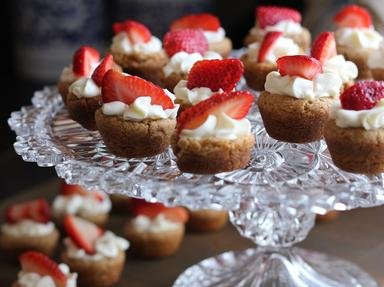Quiz Answer Key and Fun Facts
1. If you have been to a Latin American restaurant, you may have seen the sandwich cookies known as alfajores on the menu. What creamy, caramel-like substance is used as a filling for these cookies?
2. Let's remain with the letter A for the next question. What is the main flavouring in the Italian macaroon cookies known as "amaretti"?
3. Ma'amoul are delicious cookies filled with dates or nuts that can be found in most Arab countries. On what important Islamic holiday, which marks the end of Ramadan, are they usually enjoyed?
4. A striking, grown-up version of Fig Newtons, kleicha are one of the culinary symbols of which troubled Middle Eastern country?
5. Who or what are hamantashen, the traditional, triangular filled cookies of the Ashkenazi Jews, named after?
6. Koulourakia are elaborately-shaped butter cookies, sprinkled with sesame seeds, traditionally baked for Easter in what European country?
7. These petite, shell-shaped dainties from France are a bit of a literary celebrity. What is their lovely name?
8. An Indian version of shortbread, nankhatai are often made with a mix of besan flour and white wheat flour. What legume, often associated with Mediterranean cooking, is besan flour made from?
9. The pretty cookies known as "nastar" in Indonesia and "kuih ta nanas" in Malaysia are often eaten on festive occasions. What fruit is used to make the filling for these delectable treats?
10. Almond cookies made with mung bean flour are very popular snacks in which densely-populated Chinese city, a former Portuguese colony?
Source: Author
LadyNym
This quiz was reviewed by FunTrivia editor
jmorrow before going online.
Any errors found in FunTrivia content are routinely corrected through our feedback system.
